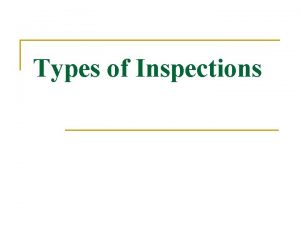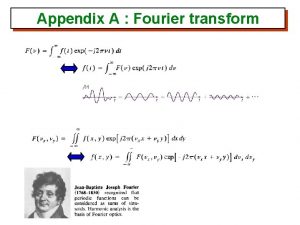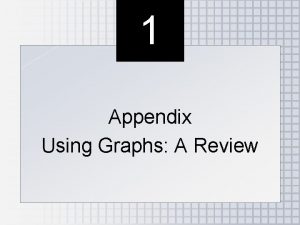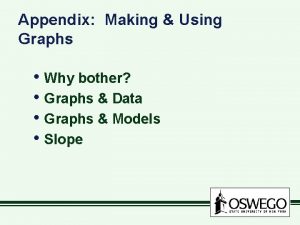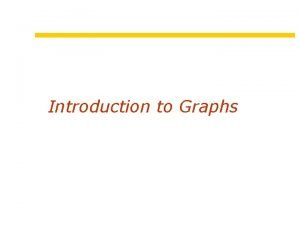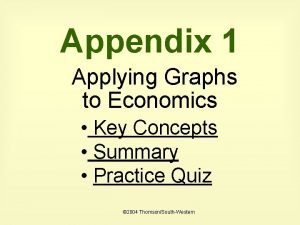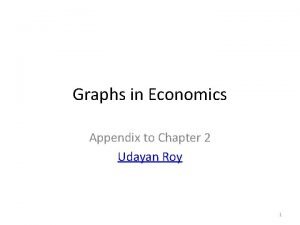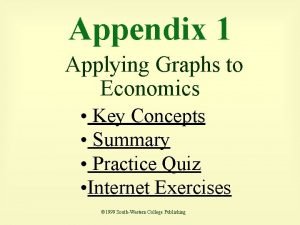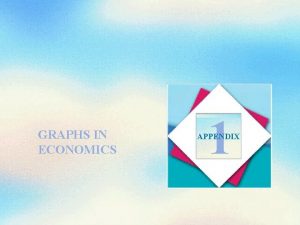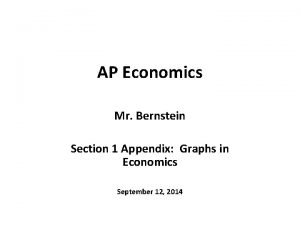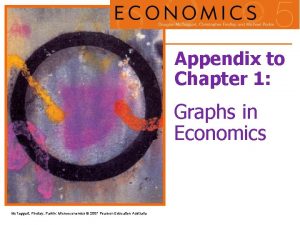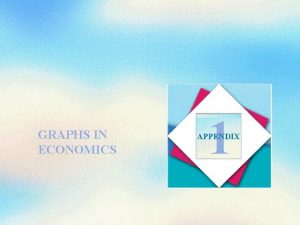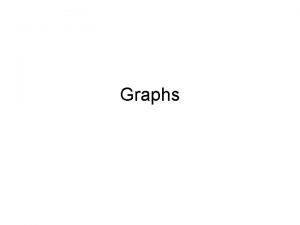PART 1 Introduction Appendix Graphs in Economics Copyright


















- Slides: 18

PART 1 Introduction Appendix: Graphs in Economics Copyright © 2006 Pearson Education Canada 1 CHAPTER

Graphing Data A graph reveals a relationship. A graph represents “quantity” as a distance. A two-variable graph uses two perpendicular scale lines. The vertical line is the y-axis. The horizontal line is the x-axis. The zero point in common to both axes is the origin. Copyright © 2006 Pearson Education Canada

Graphing Data Economists use three types of graph to reveal relationships between variables. They are § Time-series graphs § Cross-section graphs § Scatter diagrams Copyright © 2006 Pearson Education Canada

Time Series Copyright © 2006 Pearson Education Canada

Cross Section Copyright © 2006 Pearson Education Canada

Scatter Graph Copyright © 2006 Pearson Education Canada

Graphs Used in Economic Models Variables That Move in the Same Direction A relationship between two variables that move in the same direction is called a positive relationship or a direct relationship. A line that slopes upward shows a positive relationship. A relationship shown by a straight line is called a linear relationship. The three graphs on the next slide show positive relationships. Copyright © 2006 Pearson Education Canada

Graphs Used in Economic Models Variables That Move in Opposite Directions A relationship between two variables that move in opposite directions is called a negative relationship or an inverse relationship. A line that slopes downward shows a negative relationship. The three graphs on the next slide show negative relationships. Copyright © 2006 Pearson Education Canada

Graphs Used in Economic Models Variables That Have a Maximum or a Minimum The two graphs on the next slide show relationships that have a maximum and a minimum. These relationships are positive over part of their range and negative over the other part. Copyright © 2006 Pearson Education Canada

Graphs Used in Economic Models Variables That are Unrelated Sometimes, we want to emphasize that two variables are unrelated. The two graphs on the next slide show examples of variables that are unrelated. Copyright © 2006 Pearson Education Canada

The Slope of a Relationship The slope of a relationship is the change in the value of the variable measured on the y-axis divided by the change in the value of the variable measured on the x-axis. We use the Greek letter (capital delta) to represent “change in. ” So y means the change in the value of the variable measured on the y-axis and x means the change in the value of the variable measured on the x-axis. The slope of the relationship is y/ x. Copyright © 2006 Pearson Education Canada

The Slope of a Relationship The Slope of a Straight Line The slope of a straight line is constant. Graphically, the slope is calculated as the “rise” over the “run. ” The slope is positive if the line is upward sloping. Copyright © 2006 Pearson Education Canada

The Slope of a Relationship The slope is negative if the line is downward sloping. Copyright © 2006 Pearson Education Canada

The Slope of a Relationship The Slope of a Curved Line The slope of a curved line at a point varies depending on where along the curve it is calculated. We can calculate the slope of a curved line either at a point or across an arc. Copyright © 2006 Pearson Education Canada

The Slope of a Relationship Slope at a Point The slope of a curved line at a point is equal to the slope of a straight line that is the tangent to that point. Here, we calculate the slope of the curve at point A. Copyright © 2006 Pearson Education Canada

The Slope of a Relationship Slope Across an Arc The average slope of a curved line across an arc is equal to the slope of a straight line that joins the endpoints of the arc. Here, we calculate the average slope of the curve along the arc BC. Copyright © 2006 Pearson Education Canada

Graphing Relationships Among More Than Two Variables When a relationship involves more than two variables, we can plot the relationship between two of the variables by holding other variables constant—by using ceteris paribus. On the slide on the next page, we plot the relationships among three variables. Copyright © 2006 Pearson Education Canada

Copyright © 2006 Pearson Education Canada
 Transition bugs in software testing
Transition bugs in software testing Graphs that compare distance and time are called
Graphs that compare distance and time are called Graphs that enlighten and graphs that deceive
Graphs that enlighten and graphs that deceive 5-3 polynomial functions
5-3 polynomial functions Va handbook 5017
Va handbook 5017 Faa part 43 appendix a
Faa part 43 appendix a Maastricht university economics and business economics
Maastricht university economics and business economics Elements of mathematical economics
Elements of mathematical economics Factor graphs and gtsam: a hands-on introduction
Factor graphs and gtsam: a hands-on introduction Part whole model subtraction
Part whole model subtraction Unit ratio definition
Unit ratio definition Part part whole
Part part whole Part by part technical description example
Part by part technical description example 5 parts of bar
5 parts of bar The part of a shadow surrounding the darkest part
The part of a shadow surrounding the darkest part Part to part variation
Part to part variation Branches of economics
Branches of economics Introduction to engineering economics
Introduction to engineering economics Unit 1 introduction to economics
Unit 1 introduction to economics





